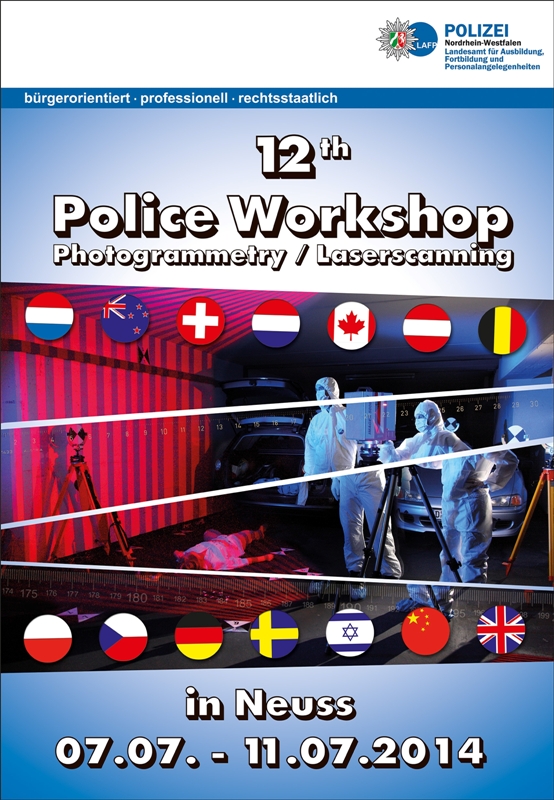The workshop took place from Monday, July 7th to Friday the 11th at the police academy in Neuss, Germany. That week saw more than 120 attendees from 14 nations come through the doors. People traveled from all over Europe and as far away as New Zealand, China, Canada, and Israel. We couldn’t be there, but friend of SPAR Jörg Meixner was on hand to jot down some daily highlights (like a Tuesday spent scanning and reconstructing a plane crash). Read through to the end of Jörg’s notes for trends and takeaways:
Monday
The workshop started on Monday at noon with a presentation from Greg Schofield of the Toronto police. He included an interesting fact: Laser scanners are now being used even in hospital operating rooms to collect evidence. Next, we saw presentations showing how laser scanning has been used to reconstruct a shooting, and heard some very interesting talks about the use of GIS for shooting and blood pattern analysis.
Tuesday
It is a tradition at the workshop to have an outdoor day where we simulate special cases, capture the scenes with laser scanning or photogrammetry, then try to reconstruct the scene and show the results to the audience one or two days later.
In previous workshops this day has featured an explosion, a suicide attack on a car, a shooting, and a fire. This time we simulated an airplane crash. An airplane body was cut into parts and scattered around an area of about one square kilometer at an open pit coalmine at Gazweiler. More than 30 dummies, seats, and smaller parts were also scattered around the area.
We had planned to capture the scene from the air using an airborne laser scanner, photogrammetry from a helicopter, and some UAVs. We planned to capture it from the ground using terrestrial laser scanners and handheld units. But on that day (surprise!) we had heavy rain and very low clouds, so most of the airborne surveys were grounded. Luckily, attendees could head to a nearby airport to have a closer look at the airborne equipment. (A special thanks to RIEGL for sending us their own plane equipped with a laser scanner.)
As for the ground-based scanners, Shabtay Negry from Mantis Vision was present with the new Pocketscan 3D (this is the first time the handheld scanner has been seen by an international audience). It looks like a promising little machine for the professional and consumer markets.
The terrestrial laser scanners and the Mantis Vision handheld scanner managed to capture the scene quite well in spite of the rain. (In some cases, though the scanners were waterproofed, it looked like the scanner operators were not!) The day ended with our traditional barbeque and public viewing of the football world championship.
Wednesday
There were several highlights on Wednesday. The first was the talk from Marcel Braum from the Stadtpolizei Zürich, Switzerland and his colleague Mr. Breitbeck, from the forensic institute. They gave us an insight into their work fusing 3D data from different sources — their combination of crime scene laser scanner data, Mantis short-range data, and the forensic medical data (CCT, MRT) is a window into the future of forensic laser scanning.
Next, Ralf Breker from LKA Bavaria [Editor’s Note: LKA stands for “landedkriminalamt,” which is the regional head office of the police. Each of the regions in Germany has its own police headquarters] and Martin Abel from LKA Hessen showed a very detailed reconstruction of the Nazi concentration camp Auschwitz-Birkenau. The reconstruction was the result of more than six months of laser scanning and reviewing historical documents and results. The data will be used in court to verify the statements of the last remaining National Socialist concentration camp persons.
Then Sandra Petershans from the LKA Stuttgart demonstrated the University of Stuttgart’s cave, a room that users can stand in to get a full 3D, 360-degree view of a scene. Audience members who tried it received a very realistic impression of the scene, much more real than seeing the data on a PC screen.
Thursday
Dave Forster of the North Yorkshire police talked about his experience using the RIEGL laser scanners in the UK. In his presentation, Heinz Schär from the Kantospolizei Zürich showed us the process he used to switch from his old equipment to terrestrial laser scanners.
The next highlight was a major step forward in the process of better connecting hardware and software. The private car-accident investigators Mr. Förtig and Mr. Lehmkuhl both use a Z+F Imager with PC Crash as their reconstruction software. These guys have been collaborating with PC Crash to develop the software, which now has a direct interface to read the laser scanner data as well as the photos taken at the accident scene by the police. An accident can be analyzed and reconstructed even years after the fact.
Friday
Prof. Mara from the University of Heidelberg presented on the algorithms he has developed for forensic tasks. His aim is to extract fingerprints automatically from the 3D data.
Trends and Takeaways
Overall, the topic on most everyone’s mind was data fusion. This was true for people who use point clouds, which they generate using different pieces of hardware but then combine, read, and store in a single piece of software. It’s true for the police as well, as they are fusing their data by combining forensic laser scanning, photography, and medical forensic data in software to document a scene more thoroughly. As for hardware, the most important trend is the development of handheld scanners like the very small Mantis Vision we saw.
To learn more about the conference or obtain a DVD of presentations, contact Jörg Meixner at [email protected]. The next workshop will be held in summer of 2016.






